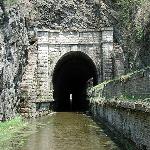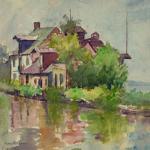29 April 2010

Photo: Wikipedia Commons
This is the famous Paw Paw Tunnel on the canal, through which boats could travel only one way at a time. The tunnel bypasses a section of the Potomac River containing five horseshoe bends.
In the early 19th Century, it was thought that canals, in which boats and barges were pulled by mules along an adjacent towpath, would revolutionize commerce and travel. One — the Erie Canal — opened the West to commerce by connecting New York's Hudson River with the Great Lakes in the heartland. It made its backers rich.
Financiers in the Washington, D.C., area also knew what canals meant to cities like Venice in Italy and Tsaritsyn — later called Stalingrad and Volgograd — in Russia. So they hurried to build a new Chesapeake & Ohio Canal from the old port of Georgetown in Washington to Pittsburgh in western Pennsylvania.
The Potomac River flows from Georgetown into the Chesapeake Bay, and Pittsburgh is on the Ohio River. Hence the Chesapeake & Ohio name.

Carol M. Highsmith
A lock on the C&O Canal, near the place where the canal begins in Washington's Georgetown section.The portion along the Potomac — 296 kilometers (184 miles) long — was completed to Cumberland in western Maryland in 1850.
It provided a calm, safe route west next to the river, which is nearly dry upstream part of the year but whose rapids rage in springtime. At its peak in the 1870s, more than 500 long, narrow boats carried cargo on the canal. Mule stables dotted the route.
But the canal company ran out of money as faster railroads stole most of their business, and the C&O Canal never reached Pittsburgh and the Ohio River.

Library of Congress
Susan Brown Chase's 1916 drawing of a C&O Canal lockmaster's house.Remnants of its 74 stone locks, as well as brick aqueducts that brought it water from the river, remain. So does one long tunnel, just wide enough for one boat to get through.
A famous standoff took place there when boats arrived from each direction, and neither captain would back off. Finally a canal company official showed up and set fire to sheaves of green corn to literally smoke the boatsmen out of the tunnel.
In the Washington area, the C&O Canal still holds water. The National Park Service runs replica boats out of Georgetown. They're a big tourist attraction. And most of the old towpath remains, all the way to Cumberland. It's a beautiful, wild trail for hikers, bikers, horseback riders — and canal lovers.